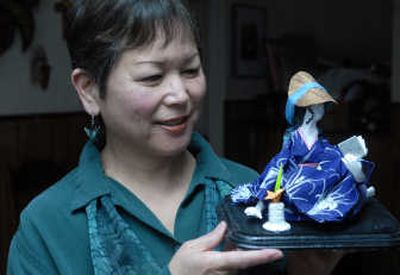Capturing a moment in paper

Sometimes the smallest things can have the most profound impact – a delicate paper crane, for instance.
Many years ago, Patti Reiko Osebold, a Japanese American born in Hawaii, saw her first origami crane – in Iowa of all places. A friend had just given birth, and someone made her a crane as part of a baby gift.
Osebold was captivated, and set about teaching herself the ancient craft of origami. “It’s like magic,” she said. “You take a two-dimensional piece of paper and make a three-dimensional figure.”
Though a nurse by profession, Osebold quickly discovered she had a knack for mastering the intricate technique of origami. Recently from her home on Spokane’s North Side her hands flew as she described the patterns she’d learned. Turtles, whales, flowers – in all their geometric complexities – fascinated her. “You can use any paper,” she said. “Even wrapping paper.”
She loved the variety and versatility of working with such a simple medium. And after moving to Spokane with her family, she found another way to explore her passion for paper. Osebold visited Mukogawa Fort Wright Institute. “I saw a Japanese paper doll,” she recalled. “The minute I saw it, I said, ‘I want to make this.’ “
The self-taught artist began to research and discovered that paper dolls appeared in Japan as early as the 1500s. The first dolls were believed to be children’s toys, but eventually they evolved into decorative works of art. “My first attempt was a disaster,” she said, laughing. “But I kept trying.”
Traditionally, the dolls are faceless so the viewer can imagine his or her own features on the doll, but Osebold chose to give her dolls facial features to add character and expression.
Her initial dolls were crafted entirely of paper. Osebold often uses chirimen – a finely crinkled paper looks and feels like fabric. She also uses rice paper and chiyogami, a traditionally patterned paper that gives the kimonos an authentic flair.
While on a trip to Hawaii, she discovered a special type of clay that’s produced only in Japan. Now, she sculpts the body of her dolls out of clay and then creates kimonos, accessories and even the hair, out of paper.
Each one of her unique dolls embodies the feel and flavor of ancient Japanese culture. For example, a kneeling woman dressed in a kimono is caught in the act of arranging tiny origami flowers. Another delicate figure holds a shamisen, a three-stringed musical instrument often played by geishas. Osebold’s great-grandfather was a shamisen maker in Japan.
Many of the dolls appear to be suspended in motion, waiting to resume their movements. Indeed, that’s exactly what Osebold strives for – to capture a moment, an idea or an activity and preserve it. She recently completed a series of martial-arts dolls. “No one has done this before,” she said.
One figure demonstrates the art of kyudo, Japanese archery. He stands with bow drawn. Osebold said the doll portrays “the calm, the act of meditation before the release of the arrow.”
Two other dolls represent Judo. One is splayed on the mat, having just been thrown, while his opponent balances on one leg beside him.
All of her figures are barefoot. The artist grew up in Hawaii and rarely wore shoes. “I love being barefoot,” she said. “I want to show the toes. I think those are fun parts of the body.”
Osebold said the creative process usually starts with an object – like a bow. “I think, who would use this bow? What would the position be? I start with an idea of what a person would be doing, and a lot of times it is the object that will carry me through to the figure.”
She points to a delicate doll clutching a tiny origami book as an example. “First, I made the book,” she said.
And that’s another thing each of her figures has in common. She includes a piece of origami with every doll. “To remind me this is where I started,” she said.
While she enjoys making the dolls, Osebold continues to incorporate origami into several kinds of art, from greeting cards, to dioramas, even jewelry. In her home studio miniscule origami crane earrings dangle from a wire to dry. Each crane is exquisitely detailed and vibrantly colored.
Osebold could have never imagined all those years ago, where her enchantment with that origami crane would lead. Looking around her workroom with several projects in various phases, she sighed and said with a smile, “My hands are always busy.”